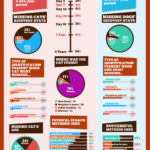July is National Lost Pet Prevention Month, a good time to go over some tips for preventing loss and improving your odds of reuniting with a lost dog or cat.
A 2012 ASPCA study shows that about 15% of owners lose a pet in a given five-year period. Roughly 85% are recovered: up to 93% of dogs and 74% cats. While cats tend to return on their own, most dogs are found during a neighborhood search. But what about the more than 7% dogs and 26% cats that are well and truly lost? Their odds of coming home are much lower, especially if they don’t have identification. But you can mitigate the risk by taking steps to avoid loss in the first place and increase your chances at reunification when loss occurs.
Preventing your pet from becoming a “lost dog” (cat) statistic
“An ounce of prevention is worth a pound of cure.” Benjamin Franklin was referring to fire prevention, but it applies here too.
Keep your pet safe and secure:
- Ensure your dog’s space is secure:
- Is the fence high enough? (cats: consider keeping them indoors, using a catio, or installing a cat fence)
- Could someone let your pet out without you knowing?
- Does your dog require a covered enclosure?
- Is the fence bite- and dig-proof?
- Are there structures or trees that your pet could use to get out?
- Never assume you know how your pet will behave in a new situation, be ready.
- Train pets to accept a leash, crate, carrier, etc.
- Have a leash handy at all times, even in no-leash areas or close to home.
- Teach your dog not to bolt out of the car, house, or any doorway.
- Spay/neuter your pet to avoid roaming.
- Use real time tracking with GPS if necessary. There are a variety of technologies available for dogs and for cats.
- Make sure your neighbors know what your pet looks like.
Prevention is great, but be prepared just in case
Animals have minds of their own. No matter how well you think you’ve accounted for every contingency, they’ll do the unexpected. So be prepared: not because you want to live in fear, but because you want peace of mind.
Improve your odds of finding a lost pet:
- Microchips: inexpensive and effective. Third-parties can use the associated data to reunite you (low-cost microchipping ).
- Tags (license, rabies, IDs): tags help but they don’t always stay on, back up with a microchip.
- Use a GPS collar to locate your lost dog or cat more quickly.
- Speed is of the essence: start your search right away. You’ll find most dogs, and many cats, through a neighborhood search.
- Let everyone know you’re looking: social media, posters, neighbors, phone trees, etc.
- Call animal control, contact local rescues, visit shelters sooner rather than later.
- Make sure vaccinations are current (low-cost vaccinations ).
- Spay/neuter also prevents your pet from producing unwanted puppies and kittens while on the lam (RRAAP spay/neuter assistance)


















